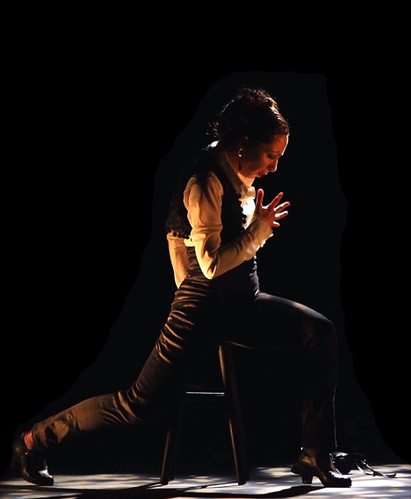
Traditional Spanish dance arrived in North Philadelphia and Main Campus through the First Philadelphia Flamenco Festival.
The First Philadelphia Flamenco Festival, hosted by Pasión y Arte and featuring the work of internationally renowned Spanish choreographer Rosario Toledo, kicked off its two-week long event on March 19 at Temple with a free master class.
While that event has passed, performances of “Cómplices,” created by Toledo for Pasión y Arte, and “Del primer Paso,” Toledo’s own performance making its U.S. debut, will be featured at the Christ Church Neighborhood House at 20 N. American St. through the end of this week. A movie night and symposium will also be held.
The festival is occurring during women’s history month from an all-female dance company that showcases, what Elba Hevia y Vaca, creator, artistic and executive director of Pasión y Arte, calls, feminist flamenco.
“When you have a male, things change,” Hevia y Vaca said. “There is always the idea of romance or this and that. My idea was really making an all-female dance company on a feminist direction, meaning empowering women, owning the woman part of ourselves and understanding how strong it is because flamenco is a great way to show that strength.”
The free master class, taught by Toledo in Pearson Hall, was the first of the festival’s events aimed at bringing the innovative dance style to the greater Philadelphia community.
“I was interested in having a narrative to flamenco,” Hevia y Vaca said. “The narrative being from a woman’s perspective – by a woman, for a woman.”
The class was filled primarily with modern dance students.
“I’ve seen it in the past so I think it will be interesting to learn it,” senior dance and psychology major Tiara Canizarez said. “It is different from anything I’ve ever actually done. I’m used to doing modern and African [dance] so I thought flamenco would be a nice change.”
Senior dance major Megan Quinn added that though she usually does modern dance, master classes are “fun” because they’re always a “different style than what we’re used to.”
Toledo, originally from Cadiz, Spain, is a classical and Spanish dancer who studied at Seville’s Dance Conservatory and has accomplished much throughout her career as a flamenco dancer and choreographer. She speaks limited English, but that did not inhibit her communication with the aspiring dancers during the class, whom she kept on beat and occasionally, in fits of laughter.
“Comedy, besides brilliance,” is Toledo’s best quality as a choreographer, as described by Hevia y Vaca. She addeed that she had wanted to work with Toledo because of, “her concept, ideas [and] her artistic direction.”
“She is very female oriented, and aesthetically, she’s brilliant,” Hevia y Vaca said.
Toledo was the first outside choreographer to work with Pasión y Arte, and she created the piece “Cómplices” exclusively for the dance company when she was doing her residency in Philadelphia.
The piece features four to five women and is a dichotomy, as it explores the whole and singularity of the dancers. There is choreography for each dancer, but the group is the most important part. It delves into components with dualities such as sensations and movement.
Music is also an important component in the dance, and is a mix of traditional flamenco and Cuban influences.
“I hear [the different music styles] and it’s very special because it’s another color in the music,” Toledo said.
Hevia y Vaca said that Pasión y Arte uses music to be innovative.
“It’s really about the interpretation of the music,” Hevia y Vaca said. “The traditional flamenco music has a very particular structure – we are limited, we have to follow the structure, the verse tells us what to do.”
“So my intention is to just do our own thing,” she added. “We can follow the structure when we want to, but then let’s just move forward and create our own particular vocabulary, using the flamenco inspiration.”
Bongo drums, electric piano and electric drums provided the music for the master class and background for Toledo’s innovative teachings. Toledo asked that no shoes be worn and as the students danced, she directed them to “release the movement” and understand the “concept of looseness with a firm grip to the earth.”
Toledo was intent on showing each student the proper steps in the dance, but encouraged them to make arm movements and turns their own. In no way was it a traditional flamenco class. The playful mood and energy belonged to a new, 21st century flamenco style with its own dialogue.
Creating communication is the goal Hevia y Vaca said she aims to accomplish through the First Philadelphia Flamenco Festival. She described the goal of the festival as “exposing people to this art form in a very different way.”
“Maybe there is an educational component, understanding that there are so many variations of flamenco, not just the stereotypes,” Hevia y Vaca said.
Hevia y Vaca moved to Philadelphia years ago, bringing her own style of Flamenco to the city, and said she always hoped that one day she could create a festival showcasing her particular take on the art form.
“This particular project, has been in gestation, exploration and finally the result for at least two and a half years,” she said.
With the project finally underway in the greater Philadelphia community, Toledo hopes to convey the strength women posses and share their stories through dance during the festival.
“The more comfortable [you are] with what you are and what you do, [then] you can actually transmit it honestly,” Toledo said.
Sinead Cummings can be reached at sinead.cummings@temple.edu.


Be the first to comment